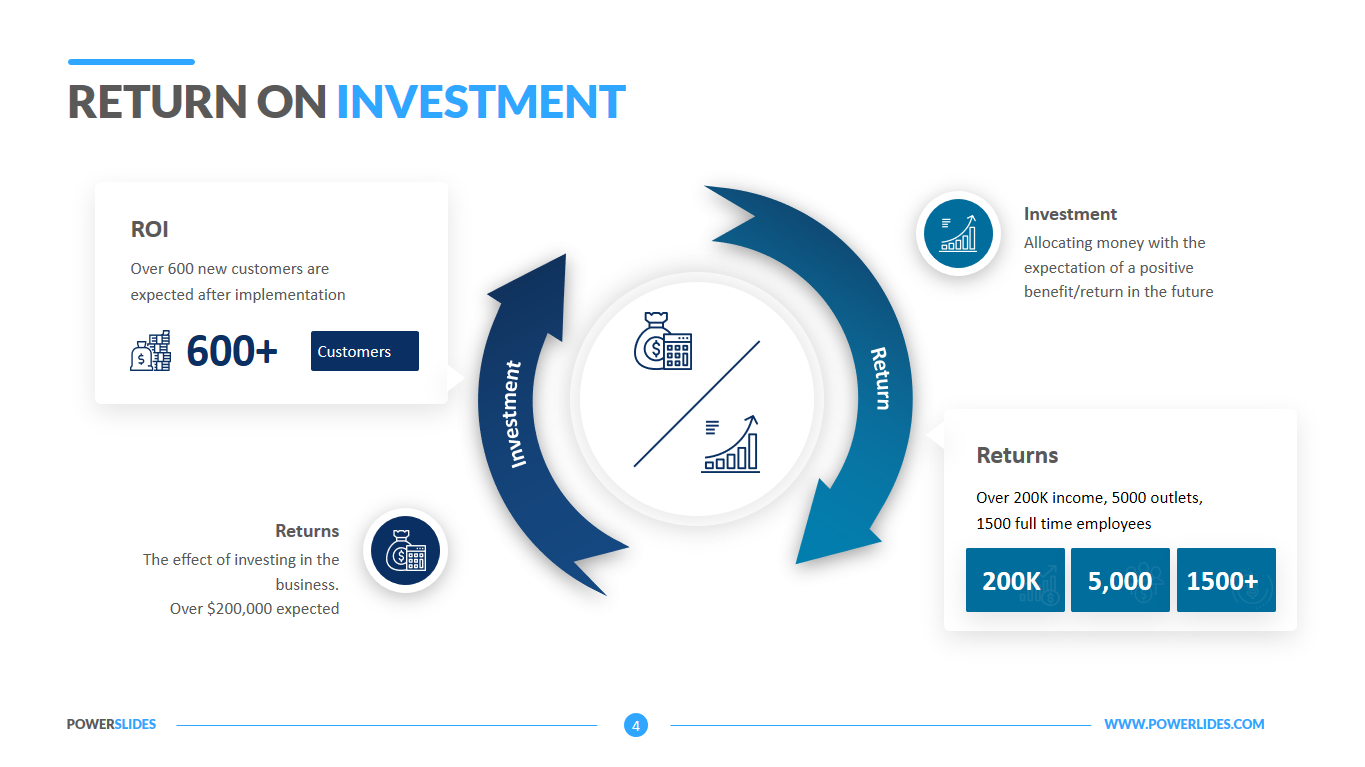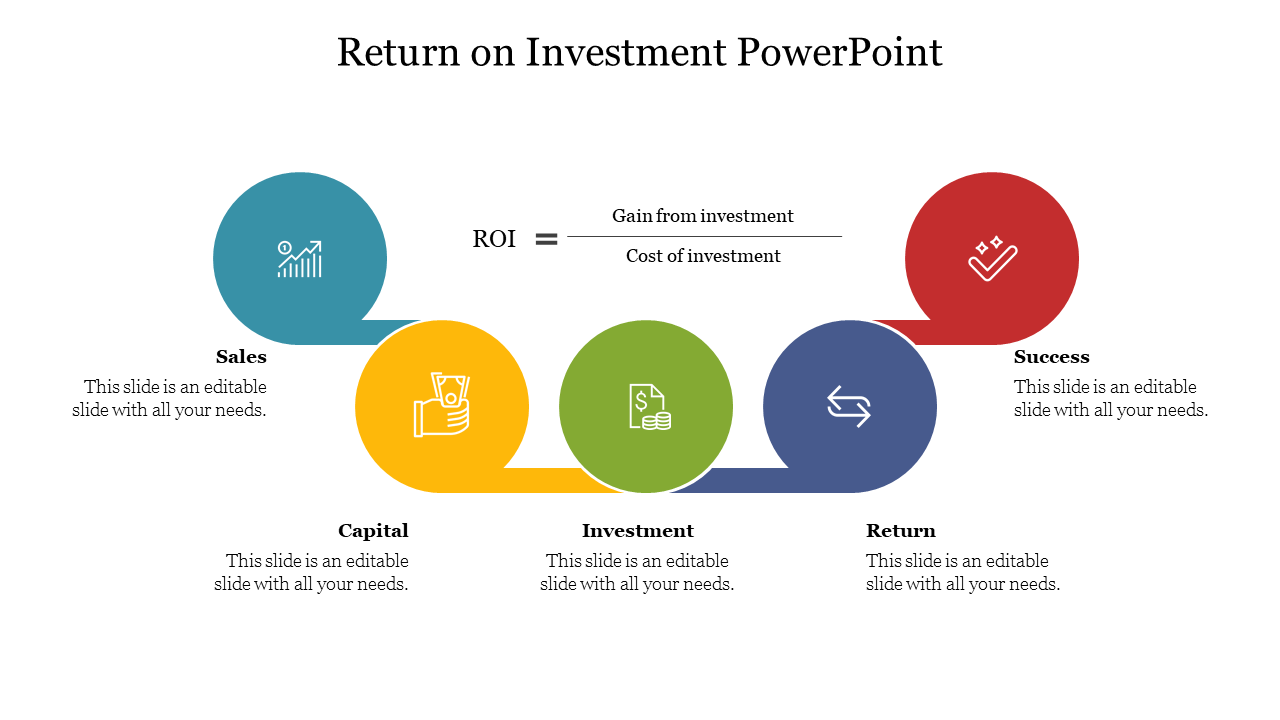Absolutely! Let’s craft a comprehensive 3000-word article about the Return on investment (ROI) slide, designed for impactful presentations. We’ll replace list items (“) with headings (`
` or `
`) to provide a structured and engaging reading experience.
In the realm of business presentations, the Return on Investment (ROI) slide stands as a pivotal element, often determining the success or failure of your pitch. It’s the moment where you translate complex data into compelling evidence, demonstrating the tangible benefits of your proposal. This article delves into the intricacies of crafting an effective ROI slide, exploring its purpose, key components, design considerations, and strategic deployment.

The primary objective of an ROI slide is to demonstrate the financial justification for your proposal. It’s not merely about presenting numbers; it’s about telling a story that resonates with your audience, showcasing how your solution will positively impact their bottom line.
Key Components of a Powerful ROI Slide
1. Clear and Concise Title

The title should immediately convey the slide’s purpose. Avoid ambiguity and opt for direct language, such as “Projected ROI,” “Financial Impact,” or “Investment Benefits.”
2. Defining the Investment

Clearly outline the costs associated with your proposal. This includes initial investment, ongoing expenses, and any other relevant financial commitments. Break down the costs into categories for clarity.
3. Quantifying the Returns
This is the heart of your ROI slide. Specify the financial gains your proposal will generate. This could include increased revenue, cost savings, improved efficiency, or any other measurable benefit.
4. Timeframe and Assumptions
State the timeframe over which the ROI will be realized. Be transparent about the assumptions used in your calculations. This builds credibility and allows for informed discussion.
5. Visual Representation
Use charts, graphs, and other visual aids to illustrate the ROI. Visuals make complex data more accessible and engaging. Common options include bar charts, line graphs, and pie charts.
6. Key Metrics and Ratios
Highlight essential metrics, such as the actual ROI percentage, payback period, and net present value (NPV). These metrics provide a clear and concise summary of the financial impact.
7. Comparative Analysis (Optional)
If applicable, compare the ROI of your proposal with alternative solutions or the status quo. This strengthens your argument and demonstrates the superior value of your offering.
The ROI slide should not be a mere collection of numbers. It should be a narrative that guides your audience through the financial logic of your proposal.
Design Considerations for Maximum Impact
1. Simplicity and Clarity
Avoid clutter and unnecessary complexity. Use a clean and professional design that prioritizes clarity. Employ a consistent color scheme and font throughout the slide.
2. Strategic Use of Visuals
Visuals should enhance understanding, not distract. Choose visuals that are relevant, easy to interpret, and aligned with your overall message.
3. Highlight Key Takeaways
Use bold text, color, or callout boxes to draw attention to crucial data points. Ensure that the most important information is easily discernible.
4. Consistency with Brand Guidelines
Maintain consistency with your company’s brand guidelines, including logo placement, color palette, and font selection. This reinforces brand identity and professionalism.
5. Data Accuracy and Verification
Double-check all calculations and data points for accuracy. Errors can undermine your credibility and damage your presentation.
6. Storytelling with Data
Use the ROI slide to tell a story about the financial benefits of your proposal. Connect the data points to real-world scenarios and demonstrate the tangible impact on the audience’s business.
Strategic Deployment of the ROI Slide
1. Timing is Crucial
Introduce the ROI slide at a point in your presentation where the audience is primed to understand its significance. Typically, this follows the presentation of the problem and your proposed solution.
2. Tailoring to the Audience
Customize the ROI slide to resonate with your specific audience. Consider their level of financial expertise and their key priorities.
3. Anticipating Questions
Prepare for potential questions about the ROI calculations, assumptions, and projections. Be ready to provide detailed explanations and supporting data.
4. Using the Slide as a Conversation Starter
The ROI slide should not be a passive display of data. Use it as a springboard for discussion and engagement. Encourage questions and address concerns.
5. Reinforcing Key Messages
Refer back to the ROI slide throughout your presentation to reinforce key messages and demonstrate the ongoing value of your proposal.
6. Providing Context and Explanation
Don’t assume your audience will automatically understand the data. Walk them through the slide, explaining each component and its significance.
1. Overly Complex Calculations
Avoid overly complex calculations that may confuse or overwhelm your audience. Stick to simple, easy-to-understand metrics.
2. Unrealistic Projections
Ensure that your projections are realistic and based on sound data and assumptions. Exaggerated claims can damage your credibility.
3. Neglecting Assumptions
Failing to disclose assumptions can lead to misinterpretations and skepticism. Be transparent about the factors that influence your calculations.
4. Ignoring the Audience’s Perspective
Tailor your ROI slide to address the specific concerns and priorities of your audience. A generic approach may fail to resonate.
5. Poor Visual Design
A cluttered or poorly designed slide can distract from your message. Prioritize clarity and simplicity in your design.
6. Lack of Supporting Data
Be prepared to provide supporting data and documentation to substantiate your ROI calculations. This builds credibility and demonstrates thoroughness.
In conclusion, the ROI slide is a critical component of any business presentation. It’s your opportunity to demonstrate the financial value of your proposal and persuade your audience to take action. By focusing on clarity, accuracy, and strategic deployment, you can craft an ROI slide that leaves a lasting impression and drives positive outcomes.
By understanding the key components, design considerations, and strategic deployment of the ROI slide, you can elevate your presentations and achieve greater success in your business endeavors. Remember, it’s not just about the numbers; it’s about telling a compelling story that resonates with your audience and demonstrates the tangible benefits of your proposal.
